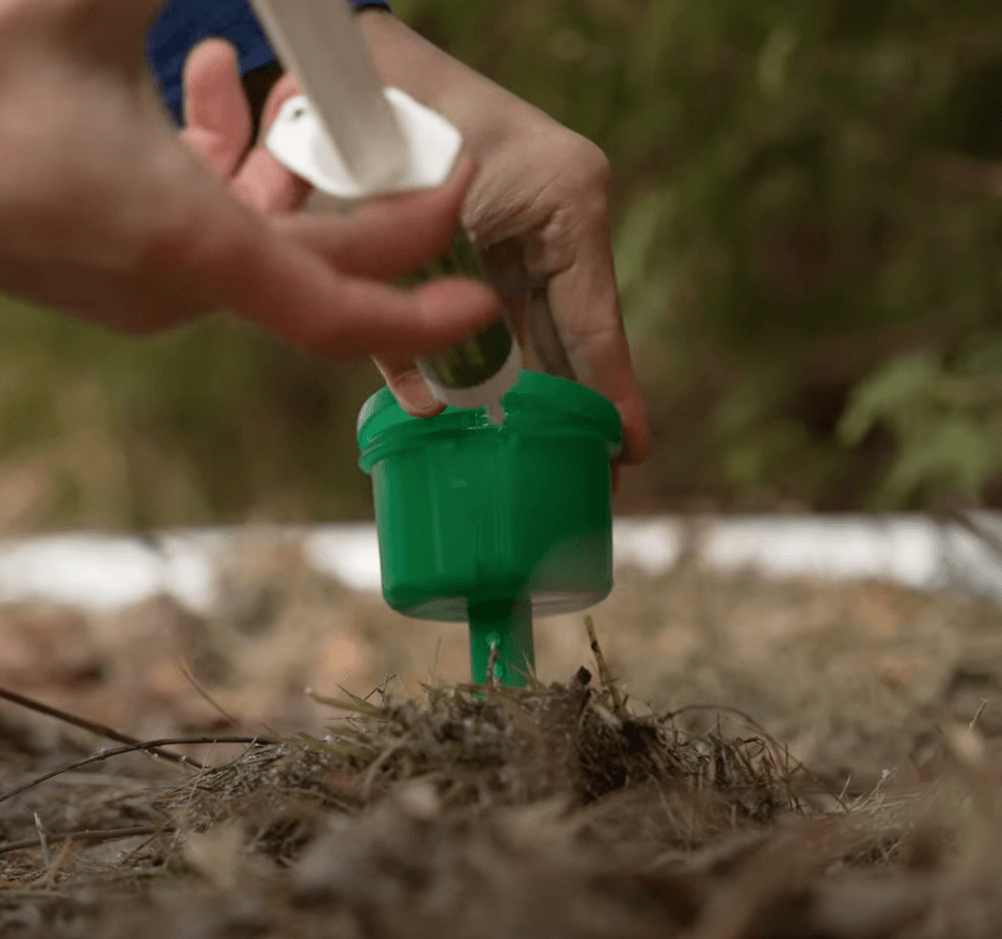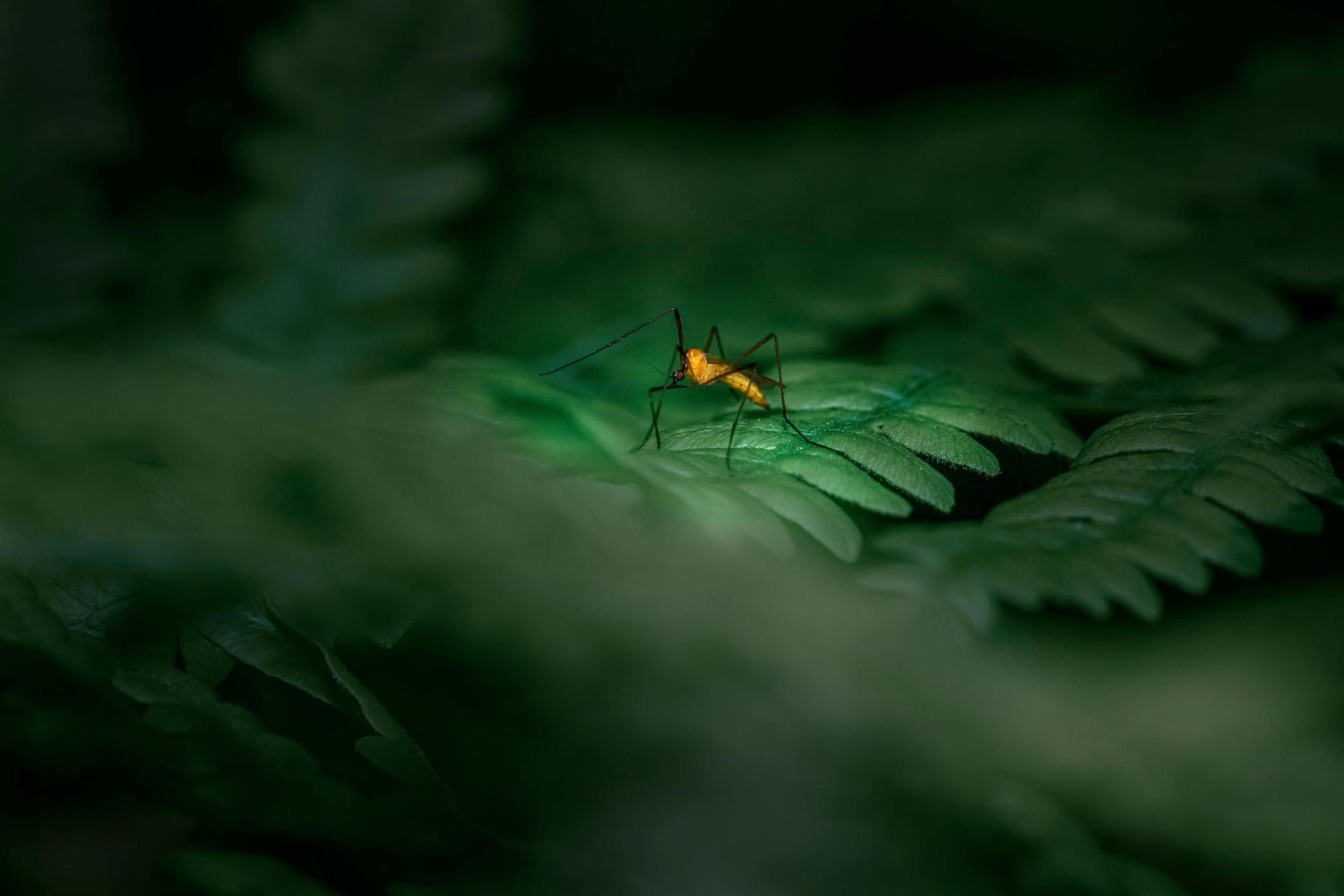
Signs of presence ⌵

General description ⌵

How to get rid of it ⌵

Dangers and damages ⌵
Signs of mosquito presence
Here are some signs that will help you identify the abnormal presence of mosquitoes:
1. Stagnant water: a breeding ground par excellence
The first sign of a possible mosquito infestation is the presence of standing water, whether in buckets, flower pots, clogged gutters, or even small pools of water. Female mosquitoes lay their eggs in standing water, where the larvae and pupae develop quickly. Even a small amount of water can harbor hundreds of eggs, accelerating an infestation if the water is not removed or treated regularly.
2. Characteristic and annoying buzzing sound
Mosquitoes produce a recognizable high-pitched buzzing sound, which is particularly noticeable when flying near the ears. This noise is mainly emitted by females and usually indicates their presence nearby. Hearing this buzzing sound frequently, especially at dusk or dawn, may signal that they are actively breeding in the area and looking for a host to feed on.
3. Presence of bites and itching
A common sign of an infestation is the appearance of small, red, itchy bites, usually on exposed skin. These bites, caused by female mosquitoes feeding on blood, are most noticeable in the early morning or evening, when mosquitoes are most active. An increase in bites on multiple people in the household may indicate that mosquitoes have made themselves comfortable in close proximity.
4. Mosquitoes cluster in shaded areas
Mosquitoes prefer to rest in dark, cool places during the day. If your property has areas of dense vegetation, such as shrubs, tall grass, or shaded shelters, these areas can serve as a haven for mosquitoes. These are areas where mosquito concentrations are typically highest.
General description of mosquitoes
Mosquitoes, small insects of the order Diptera and family Culicidae , are distinguished by their elongated, thin bodies, long, delicate legs, and proboscis, a specialized mouthpart for piercing and sucking. There are over 3,500 species of mosquitoes worldwide, with widely varying types such as Aedes , Culex , and Anopheles , each with distinct preferences for habitat and specific hosts. Mosquitoes have a pair of scale-covered wings, which is unusual among insects and unique to this family.
Mosquitoes go through four life stages: egg, larva, pupa, and adult. Larvae develop exclusively in water, often in stagnant water, such as ponds, pools, or even small containers of rainwater. Adults, after emergence, seek nectar to feed, while only females of many species require blood to produce eggs. They are attracted to carbon dioxide and the heat given off by humans, which they detect with their sensitive antennae and compound eyes that detect movement well.
Their role in ecosystems is ambivalent. Although some mosquitoes pollinate and serve as food for many predators, they are also vectors of serious diseases for humans, such as malaria, dengue fever and West Nile virus, transmitted by specific mosquito genera. The entire life cycle of a mosquito can be extremely rapid, especially in warm conditions, which contributes to their rapid expansion and makes their control difficult in populated areas.
How to get rid of mosquitoes
Mosquitoes can quickly become a nuisance, whether in your yard or inside your home. Fortunately, there are several effective methods to eliminate them while minimizing the impact on the environment. Here's a look at the best practices for getting rid of mosquitoes.
1. Eliminate sources of standing water
Mosquitoes lay their eggs in standing water, and their larvae thrive in these environments. To reduce their population, it is essential to empty any containers that hold water , such as flower pots, buckets, clogged gutters, or abandoned tires. If you have unavoidable water sources, such as fountains or ponds, you can use larvicides such as Mosquito Dunks , which kill the larvae without harming other animals.
2. Maintain the garden and outdoor spaces
Mosquitoes like dark, moist areas to rest during the day. Keeping your lawn well-maintained and trimming shrubs and hedges will reduce the areas where they can rest. Additionally, adding cedar mulch to your flower beds can also help repel these insects, as they don’t like the smell of cedar.
3. Use repellent plants
Some plants, such as lemongrass , lavender , basil , and marigolds , are naturally mosquito repellent because of their scent. Planting these herbs and flowers around your home or patio can help keep these insects away.
4. Use mosquito traps
Mosquito traps are another effective method of reducing mosquito populations. Some traps use UV lights or mimic human biological signals (such as carbon dioxide) to attract mosquitoes before trapping or killing them with an electric shock. Fake plants are also available to attract females via pheromones and capture them.
5. Ventilation and fans
Mosquitoes are lightweight, weak fliers, and have a hard time flying against strong airflow. Using an oscillating fan outdoors can greatly reduce mosquito bites in areas where you spend time, such as on a patio or deck.
6. Apply chemical or natural repellents
For more immediate solutions, you can apply chemical repellents to your skin, containing ingredients like DEET or picaridin. If you prefer natural solutions, you can also use Mosquito Barrier , a scientifically proven repellent to create a perimeter that prevents mosquitoes from entering the treated area.
By combining these prevention and treatment methods, you can effectively reduce the mosquito population around your home and enjoy the outdoors without being bothered.
The dangers and damage caused by mosquitoes
Above all a risk to human health
Mosquitoes are more than just a nuisance; they pose serious health risks due to their ability to transmit serious diseases. They spread diseases such as malaria, dengue fever, West Nile virus, Zika, and yellow fever. Each of these infections can vary in severity, but they share initial symptoms such as fever, muscle aches, rashes, and headaches. In severe cases, some of these diseases can cause neurological complications, such as meningitis, seizures, and, in rare cases, permanent damage or even death. Malaria, for example, causes millions of deaths each year, primarily in tropical and subtropical regions, while West Nile virus is a major concern in North America, potentially affecting the nervous system of those infected.
Pets also at risk
In addition to the risks to human health, mosquitoes can also infect animals, including horses and dogs, with diseases such as heartworm and equine encephalitis. Therefore, targeted prevention measures are essential to reduce mosquito proliferation and protect public health.
Limiting the harmful impact of mosquitoes includes eliminating standing water (a key breeding habitat), using repellents, and installing screens on windows. By taking these precautions, it is possible to reduce the risks associated with mosquitoes and limit their impact in residential areas.
With the purchase of a reusable half-mask respirator , get a 10% discount on the 3M vapor cartridge .
Discount code: 6TZJ
de rabais
10%
With the purchase of a Webster Cobweb brush , get a 10% discount on the Webster Cobweb extendable pole .
Discount code: DTSQ
de rabais
30%
With the purchase of a FlowZone backpack sprayer , get a 30% discount on complementary FlowZone products .
Discount code: A29B
de rabais
25%
With the purchase of the Catchmaster Ovi-Planter Ago mosquito trap , get a 25% discount on an Ungava brand mosquito repellent .
Discount code: UH5T
de rabais
25%
With the purchase of the Catchmaster Ovi-Catch Ago mosquito trap, get a 25% discount on an Ungava brand mosquito repellent .
Discount code: UH5T
de rabais
15%
With the purchase of the Envirolights JR fly light trap , get a 15% discount on the Catchmaster Flylight JR sticky panel .
Discount code: ZN7G
Best sellers
-
Mosquito Barrier, Natural Mosquito Repellent
Regular price $54.99 CADRegular priceUnit price per$59.99 CADSale price $54.99 CADSale -
UNGAVA, Mosquito Repellent Spray 25% DEET 170g
Regular price $12.99 CADRegular priceUnit price per -
UNGAVA, Mosquito Repellent Cream with Lemongrass Fragrance 120ml 30% DEET
Regular price $10.99 CADRegular priceUnit price per -
GREENSTRIKE, Automatic Technological Trap Against Mosquitoes 2.0 800CU
Regular price $238.99 CADRegular priceUnit price per

Find your solution
Do you have a pest in your home but you don't know what solution to use to get rid of it? Just answer a few questions, and you will get your solution.









